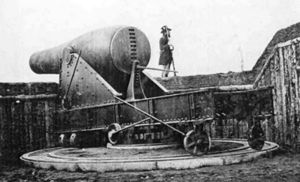Report by Colonel John H Bayne of Salubria, Prince George's County, MD
Acting Assistant Surgeon, US Army
"Report on barracks and hospitals, with descriptions of military posts"
Washington, December 5, 1870
http://www.archive.org/stream/reportonbarracks00unitrich/reportonbarracks00unitrich_djvu.txt
 |
| Fort Foote (1863-1878) - A U.S. Civil War era Coastal Fort named for Commodore Andrew H. Foote on 1 Oct 1863. The garrison was removed 10 Nov 1878 and the fort was abandoned. http://fortwiki.com/Fort_Foote |
68 DESCRIPTIONS OF MILITARY POSTS.
FORT FOOTE, MARYLAND.
KEPORT OF ACTING ASSISTANT SURGEON, JOHN. H. BAYNE, UNITED STATES ARMY.
Fort Foote is situated immediately upon the Potomac Hivrr, on the Maryland side, about eight miles below Washington City, on an elevation of land known us llozer's Bluff, at an altitude of about 100 feet above tide-water. In the rear of the fort is an extensive gorge, varying in depth from 10 to 100 feet, running the full extent of the reservation, and continuing thence to the Potomac River. A marsh about 400 yards wide, and covered with a thick growth of coarse grass and small trees, extends along the margin of the Potomac, in a northerly direction, to the distance of a mile. About a mile and a quarter below the post, in a southeasterly direction, is located a marshy tract of land of at least 200 acres, called "Broad Creek;" one-half of its area is clothed with a luxuriant growth of tall coarse grasses, interspersed with scrubby trees and bushes; the other half is composed of mud banks, the accumulation of years, brought down by floods from the hills and valleys above.
This post was established in 1862, as an adjunct to Fort Washington, four miles distant, and
was first occupied by the Ninth New York volunteers, under command of Colonel Stewart.
The fortification is constructed of earth and green timber. The quarters of the garrison, the
hospital, and other buildings in process of erection, are eligibly located upon the height back of the fort. The barrack is a new two-story wooden building, 160 feet in length, affording a sufficient capacity for two companies. The walls of the building are lined with brick, and a veranda extends its whole length in front, with a roof formed by a continuation of the roof of the building. The barrack is warmed by stoves, artificially lighted by candles, and ventilated through the roof. The dormitories, 78 by 23 feet, and 9 feet high to the caves, would each accommodate 33 men were each man allowed an air space of 600 cubic feet, but double that number have been placed in them. They are two in number, and occupy the second floor of the building. Iron bedsteads, similar to those used in the hospital department, are furnished, and over each is a shelf for the knapsack of the soldier.
The lower floor of the building contains a wash-room, mess room, kitehen, library, office, &c. The kitchen is large, and has two store-rooms adjoining. The mess-room occupies about one-third of the area of the first floor, and contains two rows of tables.
Married soldiers' quarters are five new rooms, 16 by 12 feet, one room to each family, with a porch in front, and kitchen attached to the rear of the building. Officers' quarters are two frame houses, lined with brick ; each house is a double set of quarters, each set containing four rooms.
A bomb-proof within the fort is occupied as a guard-house and prison-room ; being an earth-work, and the timbers somewhat decayed, it is illy adapted for the purposes for which it is used. It is sufficiently heated by a wood-stove, but the ceilings, which are of decayed logs, admit water in rainy weather. The floor is damp, making it very uncomfortable for the occupants. The guard, house and prison-room are doubtless causes of much sickness at this post, as nearly every private soldier in the garrison has to occupy one of these rooms underground every alternate night on guard duty.
The post bake-house is a commodious wooden building, with brick oven attached sufficiently large to turn out 350 rations of bread in a batch. The water supply is obtained from a well, a spring, and several small cisterns. There are no underdrains or sewers at the post. A system of leveling, grading, paving, and draining has been so thoroughly and unremittingly pursued that the grounds have been rendered comparatively firm and dry.
Endemic dysentery and diarrhosa have prevailed at Fort Foote with great severity during the last six months, (ending December 31, 1869,) which, superadded to the autumnal disease incident to this locality, rendered the percentage of sick very large in proportion to the command, and as tlie first two named diseases have been exclusively continue! to its limits, it is difficult to account
for their origin and prolongation.
Situated in a malarial district, interinittents, remittents, malarial dysentery and diai-rlm-a
prevail at this post during the autumnal months ; but for the period above mentioned the proportion of sickness has been far greater than that of previous seasons, while Fort Washington, a few miles below, on the Potomac River, with malarial surroundings very similar, has enjoyed the most perfect immunity from disease. The morbific, agent would thus appear to have a local origin, even within the limits of the post; but after the most careful investigation it is impossible to arrive at any satisfactory solution of the, difficulty. The cases have nearly all been very protracted, varying in duration from one to four months, and presenting nearly the same series of morbid phenomena.
The post and hospital gardens contain about three acres. Potatoes, onions, and cabbages are raised in abundance for the supply of the small company at present forming the garrison.
No comments:
Post a Comment